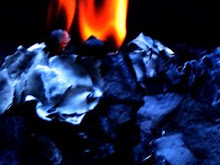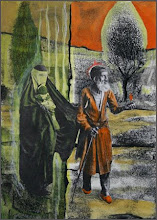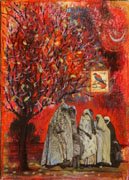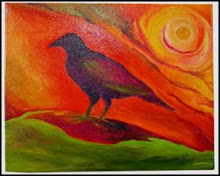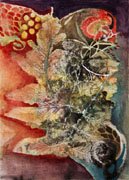After many days of raw and cool weather, the sun has graced us once again.
The stray snowflakes that taunted us less than a week ago have been replaced by 90 degrees. It is hard to get a handle on where we are in the natural scheme of things as we scratch our heads and wonder, “Where is Spring?!” The wildlife seemingly just takes it in stride and follow their inner workings...
Only recently the warblers have been joined by Rose-breasted Grosbeaks and the greening woods echo with new birdsong each day. Early this morning I heard the dulcet tones that I eagerly await all winter to hear. A male Wood Thrush is practicing the first notes of the season. In a few days the full repertoire will performed and at early morning and early evening until late August I will be aurally transported to heaven by his recital…
The peepers keep up a steady chorus throughout the evenings now and the owls enter in from time to time with unexpected vocalizations from a nearby branch that can literally startle me awake. I laugh at the absurd and exotic calls loudly proclaimed and listen for the response from deeper in the woods.
How wonderful it is to have windows open again and to hear the stirrings of life all around. This is the reward for living in a rural area and surviving the challenges of winter in New England…. a deeply satisfying one that is worth the price in my book (though whining does occur in those last few weeks…)
The hummingbirds are yet to arrive, though last night, a raccoon helped himself to the nectar I have had waiting and tipped over the birdbath to boot.
I suspect he is the same little guy who curled up on my doormat to escape the slushy snow and sticky mud weeks ago to nap in full sun.
The uniquely eerie squeals of black bear cubs scampering after their mother were heard on the evening of April 12th, the exact date that I have recorded for the last few years.
It is comforting to note some familiar patterns in these topsy-turvy times.
Usually by the end of May I manage to get photos of these shy creatures as they check out the birdfeeders in the noonday sun. Only a few visits and they will silently disappear back into the woods.
This year even skeptical friends admitted that the enormous impressions deep in the boggy backyard could only have been made by a moose. Now that would be a sight I’d love to see…
It is hard to believe that a full turn of the year has come to pass since I started this little blog last April. The blackflies are popping faster than the daffodils at this point and who knows what the weeks ahead will delight us with.
Thanks to each of you for stopping by from time to time to see what’s happening here in the hills and here's wishing you happy sightings of the wondrous things in your own backyard!
Tuesday, April 28, 2009
Tuesday, April 14, 2009
Guggenheim Show a Feast for Eye and Mind
It seems many museums are exploring the influences of East-West dialogue this year, an idea birthed in part by the travels of Marco Polo and still topical today with the enthusiasm for late 20th and early 21st C. Asian contemporary art.
“The Third Mind: American Artists Contemplate Asia, 1860-1989”is a veritable visual circus that delights the eye and engages the mind. It creatively and most successfully illustrates how the arts, philosophy and literature of Asia, much appreciated by intellectual circles in the West in the 19th and 20th C.,inspired American artists to see and experience their world in a new way.
Upon entering the rotunda and taking in Frank Lloyd Wright’s ascending ramp that spirals up six levels you are greeted by two large cubes of ice around which eight microphones peer down like inquisitive mechanical birds. This is Paul Kos’s installation “Sound of Ice Melting” (1970) created to inspire the visitor to become a deep listener, slowing the mind to become aware of the ambient environment.
Before this can be effectively achieved, dulcet tones of bronze Tibetan cymbals ring out. Tethered by a leather cord attached to a “bell carriage”draped in flowing white silk,the ethereal vehicle gracefully descends around the inner rotunda spiral. All visitors gather along the edge to cheer it on as its random, pristine chime calls us again to clarify our minds and pay attention.
This is a remarkable site-specific piece that artist Ann Hamilton created for the show using book weights of thousands of cut-up books that are reassembled in bundles to create weights that ascend and descend with a pulley system. The title of the work is called “human carriage” (2009) and it represents the power of the transmission of ideas through books.
Books were the vehicles that relayed the Eastern ideas to creative thinkers and spiritual seekers in America for the most part.
There is a short video on the Guggenheim website in which the artist explains her concept in creating this piece, as well as a wonderful introduction and virtual tour to the exhibition by Alexandra Munroe, senior Curator of Asian Art.
From iconic work by 19th C. artists such as James McNeil Whistler, Mary Cassatt, and early 20th C. O’Keefe, Dove, Stieglitz and their circle, to mid 20th C Mark Toby, Morris Graves, Franz Kline... The list just goes on and on, as over 100 artists are represented by exceptional works.
Even the Beats are visually represented, the title actually references William S. Burroughs and Brion Gysin’s recombined cut-up manuscript called “The Third Mind”. Jack Kerouac, Ferlinghetti, and others have unexpected drawings and paintings included. This chronological order culminates on the top floor which is devoted to experimental video and minimalist works from the 1980s.
This stimulating show ends on April 19th. If you find yourself in New York City before then, run don’t walk to the Guggenheim Museum. An excellent audio guide is free with the admission of $18.00 and greatly adds to the experience.
If not, at least treat yourself to a taste of the experience by taking the virtual tour on the website www.guggenheim.org !
“The Third Mind: American Artists Contemplate Asia, 1860-1989”is a veritable visual circus that delights the eye and engages the mind. It creatively and most successfully illustrates how the arts, philosophy and literature of Asia, much appreciated by intellectual circles in the West in the 19th and 20th C.,inspired American artists to see and experience their world in a new way.
Upon entering the rotunda and taking in Frank Lloyd Wright’s ascending ramp that spirals up six levels you are greeted by two large cubes of ice around which eight microphones peer down like inquisitive mechanical birds. This is Paul Kos’s installation “Sound of Ice Melting” (1970) created to inspire the visitor to become a deep listener, slowing the mind to become aware of the ambient environment.
Before this can be effectively achieved, dulcet tones of bronze Tibetan cymbals ring out. Tethered by a leather cord attached to a “bell carriage”draped in flowing white silk,the ethereal vehicle gracefully descends around the inner rotunda spiral. All visitors gather along the edge to cheer it on as its random, pristine chime calls us again to clarify our minds and pay attention.
This is a remarkable site-specific piece that artist Ann Hamilton created for the show using book weights of thousands of cut-up books that are reassembled in bundles to create weights that ascend and descend with a pulley system. The title of the work is called “human carriage” (2009) and it represents the power of the transmission of ideas through books.
Books were the vehicles that relayed the Eastern ideas to creative thinkers and spiritual seekers in America for the most part.
There is a short video on the Guggenheim website in which the artist explains her concept in creating this piece, as well as a wonderful introduction and virtual tour to the exhibition by Alexandra Munroe, senior Curator of Asian Art.
From iconic work by 19th C. artists such as James McNeil Whistler, Mary Cassatt, and early 20th C. O’Keefe, Dove, Stieglitz and their circle, to mid 20th C Mark Toby, Morris Graves, Franz Kline... The list just goes on and on, as over 100 artists are represented by exceptional works.
Even the Beats are visually represented, the title actually references William S. Burroughs and Brion Gysin’s recombined cut-up manuscript called “The Third Mind”. Jack Kerouac, Ferlinghetti, and others have unexpected drawings and paintings included. This chronological order culminates on the top floor which is devoted to experimental video and minimalist works from the 1980s.
This stimulating show ends on April 19th. If you find yourself in New York City before then, run don’t walk to the Guggenheim Museum. An excellent audio guide is free with the admission of $18.00 and greatly adds to the experience.
If not, at least treat yourself to a taste of the experience by taking the virtual tour on the website www.guggenheim.org !
Subscribe to:
Comments (Atom)









